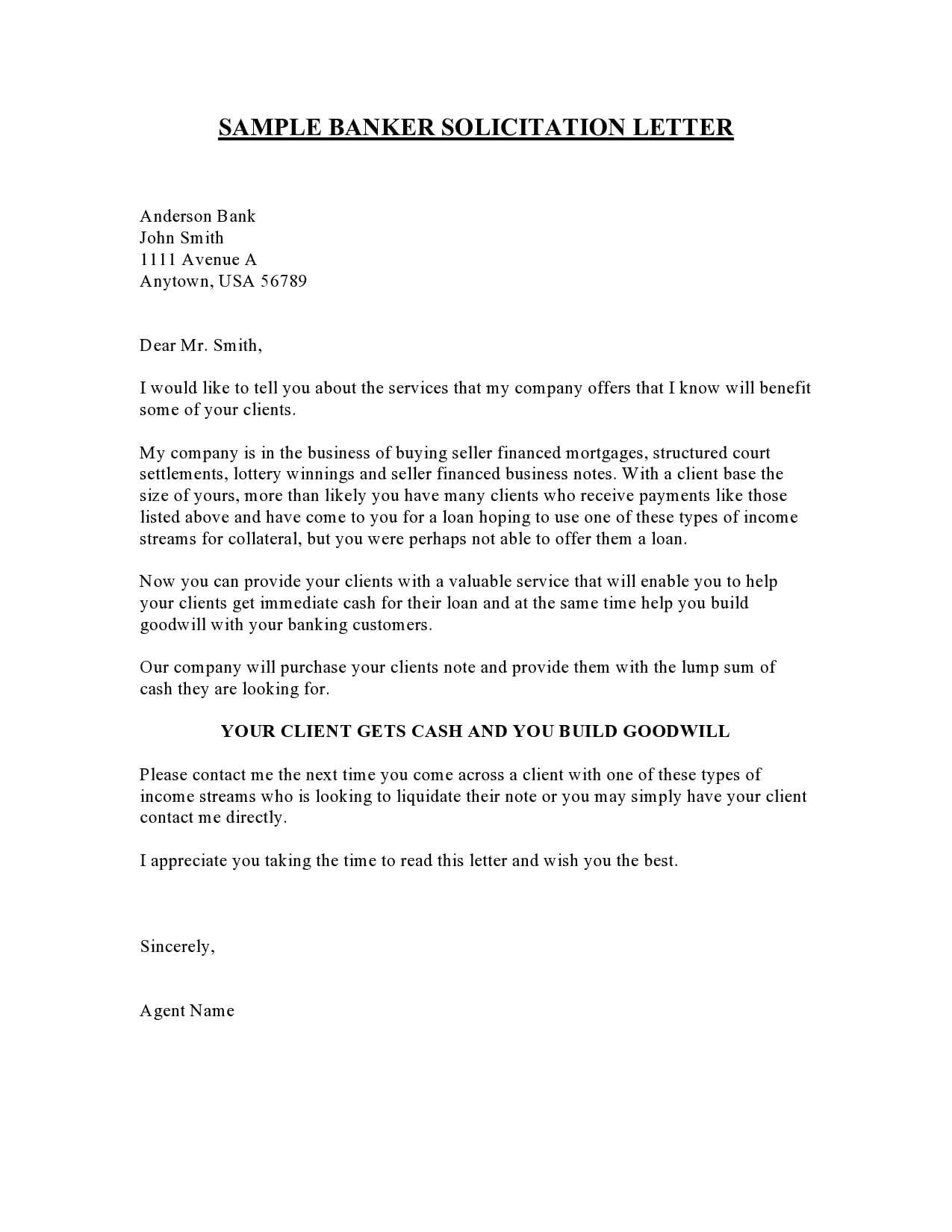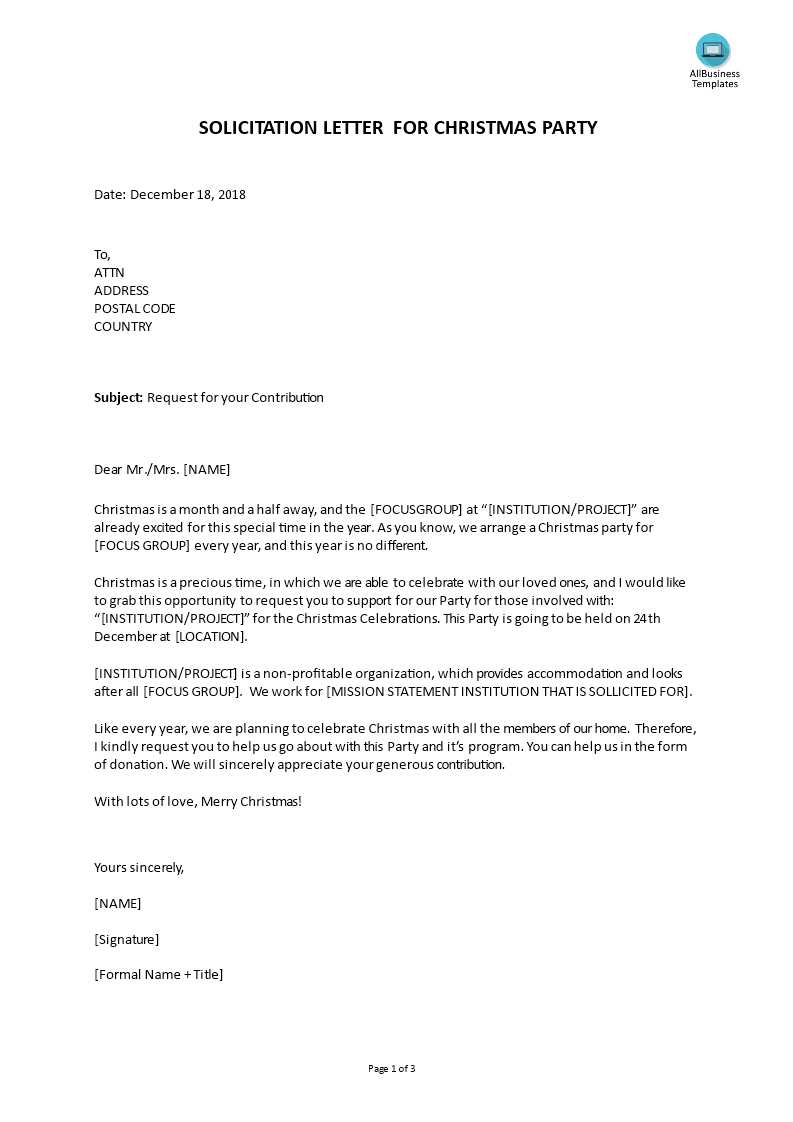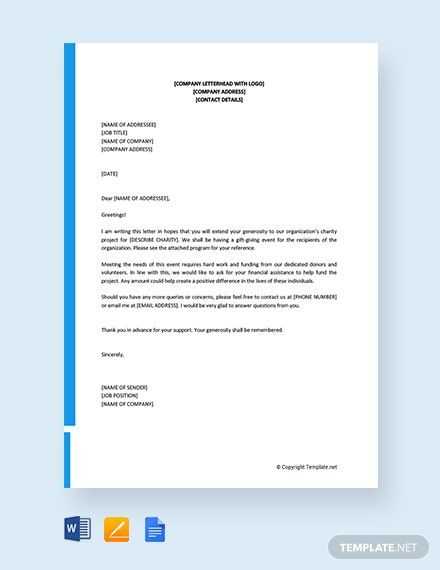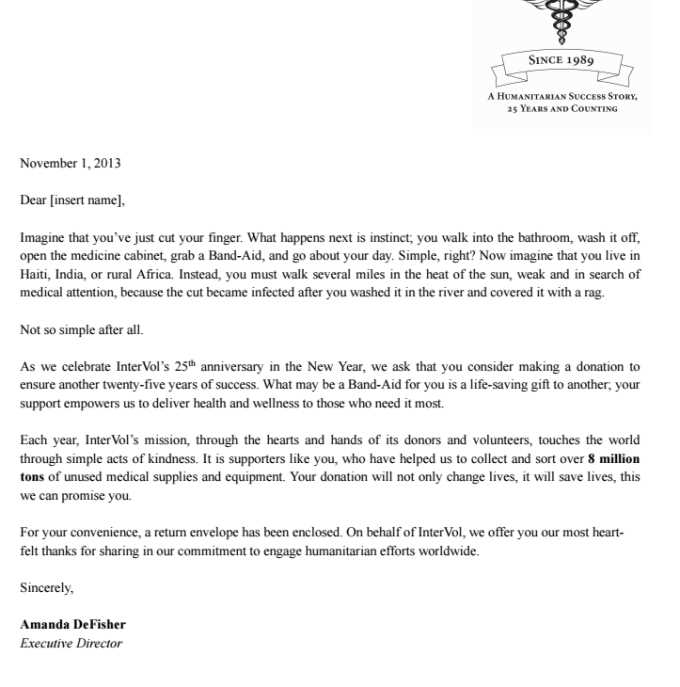Nonprofit Solicitation Letter Template for Effective Fundraising

Reaching out for financial support is a crucial aspect of sustaining an organization that relies on the generosity of others. Crafting a well-thought-out request can make all the difference in inspiring potential donors to take action. Clear and compelling communication is key to building trust and demonstrating the impact their contribution will have.
Crafting the perfect message involves more than just asking for donations. It requires conveying the mission and goals of your cause in a way that resonates with the audience. A thoughtful approach not only highlights the needs of your initiative but also fosters a genuine connection with supporters.
Designing a successful outreach involves using a structured format that speaks to the values and concerns of the target group. The message should be personal, inviting, and respectful, encouraging readers to participate in a meaningful way. By focusing on both the emotional appeal and the practicality of how contributions will be used, organizations can increase their chances of receiving the support they need.
Understanding the Importance of Fundraising Requests
When seeking financial support for a cause, it’s essential to craft a message that not only explains the need for funding but also motivates potential supporters to act. A carefully constructed appeal can greatly increase the likelihood of receiving donations. It provides clarity on the impact that each contribution will have and strengthens the connection between the organization and its audience.
Building Trust and Credibility

Effective fundraising communications establish trust by demonstrating the organization’s transparency and dedication to its mission. When potential donors feel confident that their contributions will be used wisely, they are more likely to engage and support the cause.
Encouraging Action and Engagement

A successful message inspires recipients to take immediate action. It’s not enough to simply ask for funds; the message must create a sense of urgency and importance, motivating individuals to contribute in a timely manner.
- Clarity of purpose: Clearly state how the funds will be used.
- Personalization: Tailor the message to address the specific interests of the audience.
- Call to action: Encourage immediate involvement with a straightforward ask.
By focusing on these key elements, an organization can ensure that its outreach not only informs but also moves people to support its mission, leading to long-term success in its fundraising efforts.
Key Elements of a Successful Donation Request
A well-crafted donation request must contain several critical components to engage and persuade potential contributors. Each part of the message should work together to create a compelling case for support, ensuring that recipients understand both the need for their assistance and the positive impact their gift will have.
One of the most important elements is clarity. The message should communicate the specific purpose of the funds, ensuring that donors know exactly how their contributions will be used. This transparency builds trust and increases the likelihood of receiving a positive response.
Another key aspect is emotional appeal. People are more likely to donate when they feel personally connected to the cause. Sharing powerful stories or highlighting the tangible outcomes of support can help create an emotional bond between the organization and potential donors.
Finally, a strong call to action is essential. It should be clear, direct, and easy to follow, guiding the recipient toward making a contribution. Whether it’s providing a donation link or encouraging them to take the next step, a clear ask can drive engagement and increase the chances of securing funds.
How to Personalize Your Fundraising Appeal

Personalization is a powerful tool when requesting financial support. A tailored message resonates more deeply with potential donors, making them feel valued and understood. By customizing the appeal, you not only show that you’ve considered the recipient’s interests but also create a more emotional connection, which can inspire action.
Steps to Personalize Your Request
- Address the recipient directly: Use their name to make the message feel personal and individualized.
- Reference past involvement: If the donor has contributed before, acknowledge their previous support and show appreciation.
- Align with their values: Demonstrate how their interests and your cause are connected to create a sense of shared purpose.
Effective Techniques for Personalization
- Customizable greetings: Use warm and sincere greetings that make the recipient feel special.
- Tailored content: Highlight specific aspects of your mission that align with the donor’s preferences or past involvement.
- Personalized ask: Mention a specific amount or way for the donor to contribute based on their history or capacity to give.
Personalizing a fundraising appeal makes it more likely to engage the recipient, leading to a higher probability of a positive response. It creates a sense of individual importance and helps build lasting relationships with supporters.
Common Mistakes to Avoid in Fundraising Appeals
When crafting a request for support, it’s important to avoid certain pitfalls that can diminish the effectiveness of your communication. A poorly written or poorly executed message can easily fail to engage potential donors, reducing the chances of receiving the necessary contributions. By being aware of common mistakes, you can ensure that your outreach is impactful and well-received.
Overcomplicating the Message

One common error is making the request too complicated. If the appeal is difficult to understand or too detailed, it may overwhelm the reader and discourage them from taking action. Keep the message clear, concise, and easy to follow to maintain the reader’s attention.
Being Too Vague or General
Another mistake is being overly broad or vague about how donations will be used. Donors want to know exactly where their money is going and how it will make a difference. Always provide specific examples or goals to make the request feel more tangible and relatable.
- Clear purpose: Clearly define the cause and explain how the funds will help achieve specific outcomes.
- Strong call to action: Encourage immediate involvement with a direct, easy-to-follow instruction.
- Personal connection: Avoid generic messages; instead, make the appeal feel personal and relevant to the recipient.
Avoiding these mistakes can significantly improve the effectiveness of your fundraising efforts, increasing the likelihood of garnering the support you need for your cause.
Tips for Creating an Engaging Request Design
Design plays a crucial role in ensuring that your appeal captures the reader’s attention and keeps them engaged. A well-designed message not only improves readability but also conveys professionalism, reinforcing the seriousness of the cause. The layout, font choices, and visual elements all contribute to the effectiveness of the communication, helping to draw the reader in and encourage action.
It’s important to focus on clarity and simplicity when designing the appeal. A cluttered or overly busy design can distract from the message itself. Instead, aim for a clean, well-organized layout that directs the reader’s eye naturally through the content. Use headings, bullet points, and strategic use of white space to guide the reader’s attention.
Key Design Elements
| Element | Recommendation |
|---|---|
| Fonts | Choose clear, easy-to-read fonts; avoid overly decorative ones. |
| Colors | Use contrasting colors for emphasis, but avoid overly bright or distracting shades. |
| Images | Incorporate high-quality, relevant images that enhance the message, not distract from it. |
| Layout | Use a structured layout with clear sections to make the content easily scannable. |
By paying attention to these design principles, you can create a visually appealing request that effectively conveys your message and encourages support. A well-designed appeal is more likely to be read in its entirety and prompt the reader to take action.
Best Practices for Sending Fundraising Appeals
Effective communication is key when it comes to reaching potential donors. Simply crafting a compelling request is not enough; how and when you send it can have a significant impact on its success. Following best practices for distribution ensures that your message reaches the right audience at the right time, maximizing its potential for generating support.
Timing plays a crucial role in how your appeal is received. Sending your message at the wrong time can result in it being overlooked or ignored. It’s important to consider factors such as the recipient’s schedule, seasonal giving trends, and major events related to your cause. Additionally, personalizing the delivery method and ensuring it aligns with the donor’s preferences can improve engagement.
- Choose the right medium: Consider whether an email, physical mail, or other communication channels would be most effective for reaching your audience.
- Follow-up strategically: Send reminders or thank-you messages in a timely manner, reinforcing the importance of the recipient’s support.
- Be mindful of frequency: Avoid overwhelming potential donors with too many messages. Find the right balance between staying top of mind and respecting their inbox.
By adhering to these practices, you enhance the likelihood of your request being noticed and acted upon, leading to a stronger connection with your supporters and a higher chance of success in securing contributions.
Tracking and Measuring Donation Success
Understanding the effectiveness of your fundraising efforts is essential for continuous improvement. By tracking the success of each campaign or appeal, you can gain valuable insights into what works and what doesn’t. This data helps you refine your strategies, allowing you to optimize future outreach and increase the likelihood of achieving your goals.
There are several key metrics to monitor when assessing the success of your donation campaigns. These metrics can include response rates, donation amounts, and the overall engagement of your supporters. Additionally, tracking the timing of donations and identifying patterns can provide further insight into donor behavior, helping you better tailor your future efforts.
- Response rate: Measure how many recipients of your appeal take action, such as clicking a link or making a donation.
- Average donation size: Track the average amount given by donors to gauge the overall impact of your campaign.
- Conversion rate: Calculate the percentage of people who engage with your appeal and ultimately make a contribution.
- Donor retention: Monitor how many donors return for future contributions to assess long-term engagement.
By effectively tracking and analyzing these metrics, you can better understand your audience’s preferences and continuously improve your strategies, leading to more successful fundraising initiatives over time.